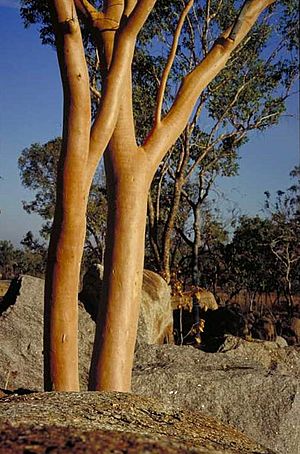Ringing gum facts for kids
Quick facts for kids Ringing gum, hills salmon gum |
|
|---|---|
 |
|
| Eucalyptus tintinnans at Pine Creek, Northern Territory | |
| Scientific classification | |
| Genus: |
Eucalyptus
|
| Species: |
tintinnans
|
| Synonyms | |
|
Eucalyptus platyphylla var. tintinnans Blakely & Jacobs |
|
The Ringing Gum (Eucalyptus tintinnans) is a special tree found only in the Top End of Australia's Northern Territory. It's also called the Hills Salmon Gum. This tree is usually small to medium-sized. It has smooth, brightly coloured bark. Its leaves can be round or triangular. You'll find its flower buds in groups of seven. When it blooms, it has white flowers. Later, it grows fruit that looks like a small cone or half-sphere.
Contents
What the Ringing Gum Looks Like
The Ringing Gum is a tree that can grow up to 15 meters tall. But often, it's shorter and might look a bit messy. By the end of the dry season, it often loses its leaves.
Bark and Leaves
The new bark on this tree is smooth and starts out orange or cream. As it gets older, it turns a salmon pink color. Just before the old bark peels off, it becomes grey.
The adult leaves are shaped like a circle or a triangle. They are about 5.5 to 11 centimeters long. They are also about 3.5 to 6 centimeters wide. Each leaf has a stem called a petiole that is 2.5 to 4.2 centimeters long.
Flowers and Fruit
The flower buds grow where the leaves meet the stem. They usually appear in groups of seven. These groups sit on a small stalk, called a peduncle, which is 2 to 6 millimeters long. Some buds sit directly on the stalk, while others have tiny stems of their own, called pedicels, up to 5 millimeters long.
When the buds are ready, they are round. They are about 4 to 7 millimeters long and 3 to 6 millimeters wide. The cap on top of the bud, called an operculum, is rounded or has a short beak.
The Ringing Gum flowers from July to September. Its flowers are white. After flowering, the tree produces a woody fruit. This fruit is shaped like a cone or half-sphere. It's about 4 millimeters long and 5 to 6 millimeters wide. Inside, there are parts called valves that are near the edge or stick out a little.
How it Got its Name
The Ringing Gum was first officially described in 1934. Two scientists, William Blakely and Maxwell Ralph Jacobs, gave it the name Eucalyptus platyphylla var. tintinnans.
Later, in 1988, two other botanists, Lawrie Johnson and Ken Hill, decided it was special enough to be its own species. They named it Eucalyptus tintinnans.
Why "Tintinnans"?
The second part of its scientific name, tintinnans, comes from a Latin word. It refers to a ringing sound. This is because hollow trees of this type often make a ringing sound when someone hits them with an axe. This unique sound gave the tree its common name, "Ringing Gum."
Where the Ringing Gum Lives
The Ringing Gum grows in sandy soil. You can find it in hilly areas or on low, stony hills. Its home stretches from near Stapleton all the way to the Kakadu National Park and Katherine Gorge in the Top End of the Northern Territory.
How We Protect the Ringing Gum
Good news! The Ringing Gum is not in danger. The Northern Territory Government has classified it as "least concern." This means there are plenty of these trees around, and they are not at risk of disappearing.

